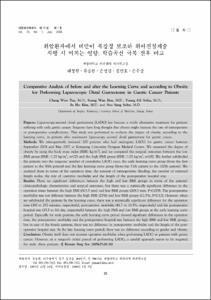위암환자에서 비만이 복강경 보조하 위아전절제술 시행 시 미치는 영향: 학습곡선 극복 전후 비교
- Keimyung Author(s)
- Ryu, Seung Wan; Son, Young Gil; Kim, In Ho; Sohn, Soo Sang
- Department
- Dept. of Surgery (외과학)
- Journal Title
- 대한외과학회지
- Issued Date
- 2008
- Volume
- 75
- Issue
- 1
- Abstract
- Purpose: Laparoscopy-assisted distal gastrectomy (LADG) has become a viable alternative treatment for patients suffering with early gastric cancer. Surgeons have long thought that obesity might increase the rate of intraoperative or postoperative complications. This study was performed to evaluate the impact of obesity, according to the learning curve, in patients who underwent laparoscopy assisted distal gastrectomy for gastric cancer.
Methods: We retrospectively reviewed 100 patients who had undergone LADG for gastric cancer between September 2004 and May 2007 at Keimyung University Dongsan Medical Center. We measured the degree of obesity by using the body mass index (BMI: kg/m2), and we compared the surgical outcomes between the low BMI group (BMI <25 kg/m2, n=72) and the high BMI group (BMI >25 kg/m2, n=28). We further subdivided the patients into the surgeons' number of cumulative LADG cases, the early learning curve group (from the first patient to the 50th patient) and the late learning curve group (from the 51th patient to the 100th patient). We analyzed them in terms of the operation time, the amount of intraoperative bleeding, the number of retrieved lymph nodes, the rate of operative morbidity and the length of the postoperative hospital stay.
Results: There no significant differences between the high and low BMI groups in terms of the patients' clinicopathologic characteristics and surgical outcomes, but there was a statistically significant difference in the operation times between the high BMI (303.3 min) and low BMI groups (269.3 min, P=0.029). The postoperative morbidity was not different between the high BMI (25%) and low BMI groups (12.5%, P=0.12). However, when we subdivided the patients by the learning curve, there was a statistically significant difference for the operation time (360 vs 297 minutes, respectively), postoperative morbidity (41.7 vs 10.5%, respectively) and the postoperative hospital stay (15.5 vs 8.6 day, respectively) between the high BMI and low BMI groups at the early learning curve period. Especially for male patients, the early learning curve period showed significant differences in the operation time, the postoperative morbidity and the postoperative hospital stay between the high BMI and low BMI groups, but in case of the female patients, there was no difference in postoperative morbidity and the length of the postoperative hospital stay. At the late learning curve period, there was no difference according to gender and obesity.
Conclusion: Obesity itself does not increase operative morbidity when performing LADG in patients with gastric cancer. However, at a surgeon's initial period of performing LADG, a careful approach seems to be required for male obese patients.
- Alternative Title
- Comparative Analysis of before and after the Learning Curve and according to Obesity for Performing Laparoscopic Distal Gastrectomy in Gastric Cancer Patients
- Publisher
- School of Medicine
- Citation
- 태창원 et al. (2008). 위암환자에서 비만이 복강경 보조하 위아전절제술 시행 시 미치는 영향: 학습곡선 극복 전후 비교. 대한외과학회지, 75(1), 20–26.
- Type
- Article
- ISSN
- 1226-0053
- Appears in Collections:
- 1. School of Medicine (의과대학) > Dept. of Surgery (외과학)
- 파일 목록
-
-
Download
 oak-bbb-02976.pdf
기타 데이터 / 346 kB / Adobe PDF
oak-bbb-02976.pdf
기타 데이터 / 346 kB / Adobe PDF
-
Items in Repository are protected by copyright, with all rights reserved, unless otherwise indicated.